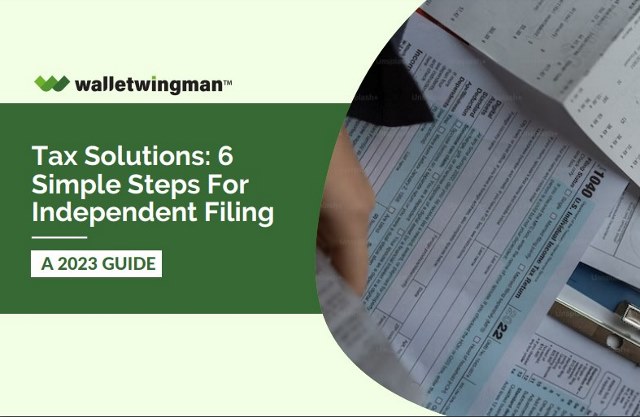Tax preparation can be a hassle and take a lot of time. However, it does not have to break the bank.
After all, the first time a young person completes their tax return is a significant turning point in their life. Your parents may have previously filed your taxes for you, but now that you are an adult, it is time for you to take responsibility for your financial situation and submit your return.
The excessive amount of tax preparation paperwork causes a lot of individuals anxiety. Fortunately, it does not need to be this way! Preparing your taxes may be a straightforward, stress-free affair. It just requires planning and time.
So should you do your own taxes? Do you get goosebumps just thinking about filing your taxes? Quit worrying! You will not need to break a sweat if you follow our clear and concise step-by-step for tax preparation.
So let’s start.
1. Find Out if You Have to File

If you’re wondering, “Should I do my own taxes” then let’s get the most important thing out of the way first. Are you required to submit taxes? You can determine by several factors, including:
- Age: The IRS has differing filing criteria for those under 65 based on their income compared to those above 65. Uncle Sam also distinguishes between those who are blind and those who are not.
- Income: Depending on your age and filing status, there is a threshold of gross income above which you must file taxes.
- Filing status: Do you intend to file as a single person, as the Head of your family, as a spouse filing jointly or independently, or as a qualified widow or widower? The required minimum income ranges from one legal group to the next. We’ll assist you in choosing your filing status sections below.
- Dependent status: Do you qualify to be someone’s dependent? If this is the case, it will also impact how high your gross income may reach before you file.
What Happens If You Become a Dependent Claimant?
The standards for figuring out your minimum income to file are different if you stand as a dependent on another person’s tax return. The Internal Revenue Service still takes into account your age and filing status, but it also takes into account whether or not you earn your money.
Earned income is what you think it is: money you labored for or earned through your efforts. This includes financial rewards such as salary, wages, and tips. Contrarily, unearned income refers to funds acquired in ways other than regular jobs. Usually, this is money you’ve earned from investments, unemployment, Social Security, or a savings account.

2. Get Your Tax Records Together
Gather all of the necessary tax paperwork to complete your tax return. If you want to make it more fun, assume it’s a treasure hunt. Which documents are required?:
- W-2s
- 1099s
- Mortgage interest declarations
- Income statements for investments
- Statements and records for charitable donations
You may also need to fill out additional forms if you’ve had significant life changes in the past year, such as getting married or relocating. The following is a list of other documents that you might have to add to your list to ensure that your tax filing proceeds without a hitch:
- Form 8822 (for moving and changing your address)
- SS-5 (For name changes)
- Form W-4 (to change withholdings for the current tax year)
Also, you want to look out for the income and investment interest forms mailed or emailed to you before the close of January. You may also find and download several of these documents through your company, mortgage financier, or bank, mortgage company.
3. Choose a Filing Status

Depending on your filing status, you may be entitled to a different standard deduction, tax bill, and tax credit.
There are situations in which selecting your file status is relatively easy, such as when you are single; nevertheless, there are also situations in which you may qualify for multiple filing statuses.
How do you determine which tax filing status to select, then? You must know the following five groups.
- Single: You will file as an individual taxpayer if you are divorced, lawfully separated, or never married.
- Couples who file jointly: If you and your spouse have decided to file your taxes together, you can select this option to save a few bucks.
- Couples who file separately: You can pick this filing status if you are married but wish to file separately from your spouse. In some cases, filing separately leads to reduced taxes.
- Breadwinner/Head of household: This one has a catch. In addition to being single and having a qualified child or dependent, you should have paid the better part of the annual household expenses. Therefore, you may be eligible for filing as the head of household when you are a single parent or caring for a sick family member.
- Qualifying widow(er): Joint filing is still an option if your spouse passes away and you don’t remarry during the tax year.
4. Select Between the Standard Deduction and Itemization
You have two options when filing your taxes: standard deduction or itemized deductions. Tax deductions reduce your taxable income; the lower your taxable income is, the less you’ll need to pay in taxes.
The question now is how do you choose which path to pursue? In the 2022 fiscal year, the standard deduction is $12,950 for unmarried and $25,900 for married couples filing together.
During the 2023 tax year, these figures will rise to $13,850 if you file as a single and $27,700 for joint couples. However, if any filer’s itemized deductions exceed these two sums, you can opt for the standard deductions to save money. Also, stand deduction users won’t worry about digging up old receipts.
At the end of the day, your payable tax or tax refund will vary based on the type of deduction your choose.
5. Choose a Suitable Filing Approach
So you got the necessary documents and information we mentioned above, and now you’re ready to file your taxes. Just know you have two options at your disposal:
- Working with a tax expert
- Filing yourself with a free tax tool online
In 2021, the IRS reported that approximately half of all Americans used the assistance of a professional tax expert, while the remaining 43 percent filed their taxes on their own using tax software. The other 7% did things old-fashioned and sent in paper forms.
But how do you know which form to file? Here is a general guideline for deciding whether to file your taxes online or through a tax professional:
Using software that is accessible online can be simple if your tax situation is uncomplicated. However, you should try out online tax software if you don’t mind spending some extra time on your return. You can always change your mind at any point and speak with a tax professional if you decide you’d feel more at ease having someone else prepare your return. Using tax software is free of charge until you submit your return, at which point you will be asked to pay.
If, on the other hand, your tax return is more involved because, for example, you operate a business or feel overwhelmed by the various forms and paperwork, it is advisable to employ a tax specialist who is familiar with the ins and outs of everything about taxes.
6. File Your Returns Using Software Available Online

The first step in filing your taxes electronically is to choose which tax preparation program you will use. Here are the best options to explore.
- Free IRS File
Tax filing is free through the Internal Revenue Service (IRS) tax filing program called IRS Free File. It gives step-by-step help with preparing federal and some state tax forms from the program’s partners. If you want to qualify for the Adjusted Gross Income (AGI) exemption, your annual income must be less than $73,000.
- Research Other Online Tax Tools
A lot of people use online tax tools to do their taxes. After all, these firms typically streamline the filing procedure and ensure you get the most out of your deductions and refund.
Multiple pricing tiers and free software versions are usually available for download with these programs. However, these free versions have fewer features and less assistance, but they can still be a good choice for those filing simple taxes.
Depending on the level of detail of your taxes, you can choose from different pricing plans and alternatives, ranging from basic, designed for easy tax returns, to Self-Employed, for independent contractors, contract workers, and passive income taxes. Additionally, you may subscribe to the Premium tier and enjoy live chat with a tax expert.
Summary
There are numerous methods to save money on tax preparation, particularly if you meet the criteria for any IRS programs. But remember that saving money on tax filing is not always the smartest thing to do, particularly if you don’t want to find out what happens if you don’t file taxes for 3 years.
Say you anticipate that your tax return will be more complex than usual — for example, if you work as a freelancer or if you have recently purchased or sold a home — you may want to consider getting professional help to benefit from live support, maximize your deductions, and increased financial peace.
Several high-end tax services also provide reliability and max refund guarantees, which pay you back if the software makes a mathematical error in your tax return.



